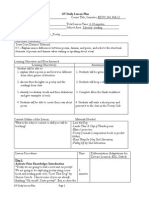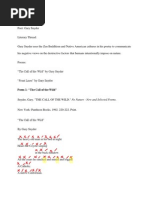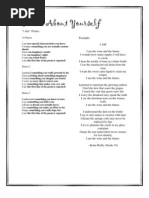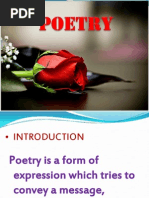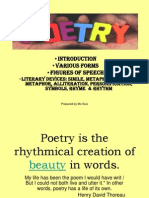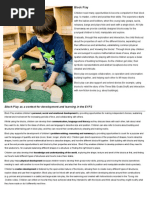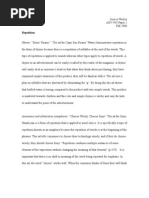Poetry Forms
Poetry Forms
Uploaded by
cmaroisCopyright:
Available Formats
Poetry Forms
Poetry Forms
Uploaded by
cmaroisOriginal Description:
Copyright
Available Formats
Share this document
Did you find this document useful?
Is this content inappropriate?
Copyright:
Available Formats
Poetry Forms
Poetry Forms
Uploaded by
cmaroisCopyright:
Available Formats
This one gets it's own entry because of the list below. Each item represend a fo rm of poetry.
They are in no paticular order but they are all forms I want to tr y. Abcedarian A poem having verses/words beginning with successive letters of the alphabet. Ballad The first ballads appeared in the 15th century telling a story. They were often in the form of popular songs and have simple rhyme schemes and regular rhythm. T hey are iambic and some have a chorus or refrain. Popular rhyme schemes are a b c b; and a b c b d b. Ballade The Ballade is a French form composed of three stanzas of eight lines and an env oy of four lines, with the last line of each stanza a refrain. It is usually iam bic and the most common line lengths are eight or ten syllables. The rhyme schem e is ababbcbC ababbcbC ababbcbC bcbC. Blank verse Poetry that is written in unrhymed iambic pentameter. Blank verse is often unobt rusive and the iambic pentameter form often resembles the rhythms of ordinary sp eech. Shakespeare wrote most of his plays in blank verse. Burlesque Burlesque is a story, play, or essay, that treats a serious subject ridiculously , or is simply a trivial story Canzone A medieval Italian lyric poem, with five or six stanzas and a shorter concluding stanza (or envoy). Carpe diem A Latin expression that means "seize the day." Carpe diem poems have the theme o f living for today. Cinquain The traditional cinquain is based on a syllable count. line 1 - 2 syllables line 2 - 4 syllables line 3 - 6 syllables line 4 - 8 syllables line 5 - 2 syllables The modern cinquain is based on a word count of words of a certain type. line 1 - one word (noun) a title or name of the subject line 2 - two words (adjectives) describing the title line 3 - three words (verbs) describing an action related to the title line 4 - four words describing a feeling about the titlem, a complete sentence line 5 - one word referring back to the title of the poem Classicism The principles and ideals of beauty that are characteristic of Greek and Roman a rt, architecture, and literature. Examples of classicism in poetry can be found in the works of John Dryden and Alexander Pope, which are characterized by their formality, simplicity, and emotional restraint. Couplet A couplet has rhyming stanzas each made up of two lines. Shakespearean sonnets u
sually end in a couplet. Elegy A sad and thoughtful poem lamenting the death of a person. An example of this ty pe of poem is Thomas Gray's "Elegy Written in a Country Churchyard." Epic A long, serious poem that tells the story of a heroic figure. Two of the most fa mous epic poems are the Iliad and the Odyssey by Homer and the epic poem of Hiaw atha. Epigram A very short, satirical and witty poem usually written as a brief couplet or qua train. The term epigram is derived from the Greek word epigramma, meaning inscri ption.The epigram was cultivated in the late sixteenth and seventeenth centuries by poets like Ben Jonson and John Donne Epitaph An epitaph is a commemorative inscription on a tomb or mortuary monument written in praise of a deceased person Epithalamium (or Epithalamion) A wedding poem written in honour of a bride and bridegroom. Free verse (also vers libre) Poetry composed of either rhymed or unrhymed lines that have no set fixed metric al pattern or expectation. Haiku A haiku is an unrhymed 17 syllable poem of Japanese origin. It usually has a sea sonal reference.The structure is: line 1 - 5 syllables line 2 - 7 syllables line 3 - 5 syllables Idyll, or Idyl Either a short poem depicting a peaceful, idealized country scene, or a long poe m that tells a story about heroes of a bye gone age. Lay A lay is a long narrative poem, especially one that was sung by medieval minstre ls called trouvres. Limerick A short sometimes bawdy, humorous poem of consisting of five anapaestic lines. L ines 1, 2, and 5 of a Limerick have seven to ten syllables and rhyme with one an other. Lines 3 and 4 have five to seven syllables and also rhyme with each other . Lyric A poem, such as a sonnet or an ode, that expresses the thoughts and feelings of the poet. The term lyric is now generally referred to as the words to a song. Acrostic A verse in which certain letters such as the first in each line form a word or a message Narrative Poetry Ballads, epics, and lays are different kinds of narrative poems.
Pastoral A poem that depicts rural life in a peaceful, idealized way for example of sheph erds or country life. Quatrain A stanza or poem of four lines. Lines 2 and 4 must rhyme. Lines 1 and 3 may or may not rhyme. Rhyming lines should have a similar number of syllables. Rhyme A rhyme has the repetition of the same or similar sounds at the end of two or mo re words most often at the ends of lines. There are several derivatives of this term which include double rhyme, Triple rhyme, rising rhyme, falling rhyme, Perf ect and imperfect rhymes. Rhyme royal A type of poetry introduced by Geoffrey Chaucer consisting of stanzas of seven l ines in iambic pentameter. Romanticism Nature and love were a major themes of Romanticism favoured by 18th and 19th cen tury poets such as Byron, Shelley, and Keats. Emphasis was placed on the persona l experiences of the individual. Senryu A senryu is a three line Japanese poem structurally similar to haiku. It is unrh ymed and the subject is based human nature. It is usually satirical or ironic. line 1 - 5 syllables line 2 - 7 syllables line 3 - 5 syllables Tanka Tanka is a form of unrhymed Japanese poetry, with five sections totalling 31 onj i (phonological units identical to morae), structured in a 5-7-5 7-7 pattern. Th ere is generally a shift in tone and subject matter between the upper 5-7-5 phra se and the lower 7-7 phrase. Terza rima A type of poetry consisting of 10 or 11 syllable lines arranged in three-line "t ercets". The poet Dante is credited with inventing terza rima and it has been us ed by many English poets including Chaucer, Milton, Shelley, and Auden. Sonnet The Shakespearian sonnet, also known as the English Sonnet, is written in fourte en lines of in iambic pentameter. It uses alternative rhyme connecting different images and a final couplet forming a conclusion. The Shakespearean sonnet is fl exible in its volta, or turning point, (Shakespeare often used line 9), and has a rhyme scheme of abab,cdcd,efef,gg.. Verse A single metrical line of poetry, or poetry in general (as opposed to prose). Climbing Rhyme Burmese poetry has a long and distinguished history. Classical Burmese poetry co mes in many lengths and forms, but most of it is characterized by a repeated seq uence of 3 internally-rhymed lines consisting of 4 syllables each a pattern that h
as become known as Climbing Rhyme. Most Burmese patterns employ a scheme of internal rhyme: the same rhyme appears in the 4th syllable of line 1, the 3rd syllable of line 2 and the 2nd syllable o f line 3. This is called the 4-3-2 scheme; its characteristic stairstep gave ris e to its name, climbing rhyme. The last syllable of line 3 begins a new series o f rhymes, continuing the 4-3-2 pattern. Dodoitsu The Dodoitsu is a fixed folk song form of Japanese origin and is often about lov e or humor. It has 26 syllables made of of four lines of 7, 7, 7, 5 syllables re spectively. It is unrhymed and non-metrical. Ghazal The ghazal (Arabic: ghazal, Persian: ghazel, Turkish/Azerbaijani: gazel, Urdu: g azal, Bengali/Sylheti: gozol) is a form of poetry common in Arabic, Persian, Tur kish, Azerbaijani, Urdu and Bengali poetry. In classic form, the ghazal has from five to fifteen rhyming couplets that share a refrain at the end of the second line. This refrain may be of one or several syllables, and is preceded by a rhym e. Each line has an identical meter. Each couplet forms a complete thought and s tands alone, and the overall ghazal often reflects on a theme of unattainable lo ve or divinity. The last couplet generally includes the signature of the author. The Haibun a linked form. The link is between narrative, prose sections and one or more hai ku. "wide range of styles and content. minimal repetition of words and phrases; "what is written is tightly constructed ". strong haiku that can stand alone as poetry. "Haiku ... relate to previous prose sections yet not be an extension of the pros e. The oblique but relevant association between haiku and prose is the defining moment of the haibun. ... The haiku link offers readers a springboard to multipl e, and often unexpected, meanings." Pantoum In a traditional Pantoum: The lines are grouped into quatrains (4-line stanzas). The final line of the Pantoum must be the same as its first line. A Pantoum has any number of quatrains. Lines may be of any length. The Pantoum has a rhyme scheme of abab in each quatrain. Thus, the lines rhyme a lternately. The Pantoum says everything twice: For all quatrains except the first, the first line of the current quatrain repea ts the second line in the preceeding quatrain; and the third line of the current quatrain repeats the fourth line of the preceeding quatrain. In addition, for the final quatrain, its second line repeats the (so-far unrepea ted) third line in the first quatrain; and its last line repeats the (so-far unr epeated) first line of the first quatrain. Thus the pattern of line-repetition is as follows, where the lines of the first quatrain are represented by the numbers "1 2 3 4": 1 2 5 7 2 5 7 9 3 4 6 8 4 6 8 10 Lines Lines Lines Lines in in in in first quatrain. second quatrain. third quatrain. fourth quatrain.
9 3 10 1
- Lines in fifth and final quatrain.
In this example, we have 5 quatrains. You could have more. You could have fewer. Than-Bauk A Than-Bauk, conventionally a witty saying or epigram, is a three line "climbing rhyme" poem of Burmese origin. Each line has four syllables. The rhyme is on th e fourth syllable of the first line, the third syllable of the second line, and the second syllable of the third line. Jintishi The jintishi is a Chinese poetic form based on a series of set tonal patterns us ing the four tones of Middle Chinese in each couplet: the level, rising, departi ng and entering tones. The basic form of the jintishi has eight lines in four co uplets, with parallelism between the lines in the second and third couplets. The couplets with parallel lines contain contrasting content but an identical gramm atical relationship between words. Jintishi often have a rich poetic diction, fu ll of allusion, and can have a wide range of subject, including history and poli tics. One of the masters of the form was Du Fu, who wrote during the Tang Dynast y (8th century). There are several variations on the basic form of the jintishi. Sestina The sestina has six stanzas, each comprising six unrhymed lines, in which the wo rds at the end of the first stanza s lines reappear in a rolling pattern in the ot her stanzas. The poem then ends with a three-line stanza in which the words agai n appear, two on each line. Villanelle The villanelle has 19 lines, 5 stanzas of three lines and 1 stanza of four lines with two rhymes and two refrains. The 1st, then the 3rd lines alternate as the last lines of stanzas 2,3,and 4, and then stanza 5 (the end) as a couplet. It is usually written in tetrameter (4 feet) or pentameter.The structure is: line 1 - a - 1st refrain line 2 - b line 3 - a - 2nd refrain line 4 - a line 5 - b line 6 - a - 1st refrain (same as line 1) line 7 - a line 8 - b line 9 - a - 2nd refrain (same as line 2) line 10 - a line 11 - b line 12 - a - 1st refrain (same as line 1) line 13 - a line 14 - b line 15 - a - 2nd refrain (same as line 2) line line line line 16 17 18 19 a b a - 1st refrain (same as line 1) a - 2nd refrain (same as line 2)
Rondeau The rondeau consists of three stanzas, a quintet (5 lines), a quatrain (4 lines) and a sestet (6 lines). The first phrase of the first line usually sets the ref rain (R), but sometimes the refrain can be the whole of the first line. The stru cture is: line line line line line line line line line line line line line line line 1 2 3 4 5 6 7 8 9 10 11 12 13 14 15 a (R)(normally the first phrase is the refrain) a b b a a a b R a a b b a R
Rondelet The rondelet is a french form consisting of two rhymes contained in a seven line stanza. Line one is the exact same as the 3rd and 7th lines. The structure is: line line line line line line line 1 2 3 4 5 6 7 4 8 4 8 8 8 4 syllables syllables syllables syllables syllables syllables syllables A (the same as line 3 and 7) b A a b b A
Triolet A triolet is an eight line poem or stanza with a set rhyme scheme. Line four and line seven are the same as line one, and line eight is the same as line two. Th e rhyme scheme is ABaAabAB. line line line line line line line 1 3 4 5 6 7 8 Aline 2 a A (line a b A (line B (line - B 1) 1) 2)
Ode Odes were first developed by poets writing in ancient Greek, such as Pindar,[72] and Latin, such as Horace. Forms of odes appear in many of the cultures that we re influenced by the Greeks and Latins.[73] The ode generally has three parts: a strophe, an antistrophe, and an epode. The antistrophes of the ode possess simi lar metrical structures and, depending on the tradition, similar rhyme structure s. In contrast, the epode is written with a different scheme and structure. Odes have a formal poetic diction, and generally deal with a serious subject. The st rophe and antistrophe look at the subject from different, often conflicting, per spectives, with the epode moving to a higher level to either view or resolve the
underlying issues. Odes are often intended to be recited or sung by two choruse s (or individuals), with the first reciting the strophe, the second the antistro phe, and both together the epode. Over time, differing forms for odes have devel oped with considerable variations in form and structure, but generally showing t he original influence of the Pindaric or Horatian ode. One non-Western form whic h resembles the ode is the qasida in Persian poetry. Clerihew A clerihew is 'a humorous pseudo-biographical quatrain, rhymed as two couplets, with lines of uneven length more or less in the rhythm of prose". The name of th e subject is usually at the end of the first line (sometimes the second line) an d is well known. The humour of the clerihew is whimsical rather than satiric. Concrete poetry Concrete (or shape) poetry is an inventive form where the poetry takes on the sh ape of its subject. Diamonte The diamonte is fun and easy to write. The purpose is to go from the subject at the top of the diamond to another totally different (and sometimes opposite) sub ject at the bottom. The structure is line 1 - one noun (subject #1) line 2 - two adjectives (describing subject #1) line 3 - three participles (ending in -ing, telling about the subject #1) line 4 - four nouns (first two related to the subject #1, second two related to subject #2) line 5 - three participles (ending in -ing, telling about subject #2) line 6 - two adjectives (describing subject #2) line 7 - one noun (subject #2) Kyrielle The Kyrielle is a French form written in quatrains. Each quatrain contains a rep eated line or phrase as a refrain. It has a meter usually composed of eight syll ables per line but it can be varied. There is no limit to the number of stanzas, but three is generally the minumum. The normal structure is a/a/b/B, c/c/b/B, d/d/b/B. with B being the repeated lin e.A varied structure could be a/b/a/B, c/b/c/B, d/b/d/B. etc.or even a second li ne that did not rhyme at all. a/e/a/Z etc. Nonet A nonet has nine lines. The first line has nine syllables, the second line eight syllables, the third line seven syllables, etc... until line nine that finishes with one syllable. It can be on any subject and rhyming is optional. line line line line line line line line line 1 2 3 4 5 6 7 8 9 9 8 7 6 5 4 3 2 1 syllables syllables syllables syllables syllables syllables syllables syllables syllables
Parallelismus Membrorum Parallelismus Membrorum is of traditional Hebrew origin. It has lines of paralle l construction and presents antitheses and complementary extensions. The lines a re usually short and contain three or four words.
Quatern A Quatern is a sixteen line French form composed of four quatrains. It is simila r to the Kyrielle and the Retourne. It has a refrain that is in a different plac e in each quatrain. The first line of stanza one is the second line of stanza tw o, third line of stanza three, and fouth line of stanza four. A quatern has eigh t syllables per line. It does not have to be iambic or follow a set rhyme scheme . line line line line line line line line line line line line line line line line 1 2 3 4 5 6 (line 1) 7 8 9 10 11 (line 1) 12 13 14 15 16 (line 1)
Rictameter A rictameter is a nine line poetry form. The 1st and last lines are the same wit h the syllable count as follows: line line line line line line line line line 1 2 3 4 5 6 7 8 9 2 syllables - same as line 9 4 syllables 6 syllables 8 syllables 10 syllable 8 syllables 6 syllables 4 syllables 2 syllables - same as line 1
Tetracty Tetractys should express a complete thought, profound or comic, witty or wise us ing 20 syllables. They can be written with more than one verse but each subseque nt verse must invert the syllable count. There is no limit to the number of vers es. The structure is: line line line line line 1 2 3 4 5 1 syllable 2 syllables 3 syllables 4 syllables 10 syllables
Tyburn A tyburn is a six line poem with a set syllable count.The first four lines rhyme and are all descriptive words. The last two lines rhyme and incorporate the 1st , 2nd, 3rd, and 4th lines as the 5th to 8th syllables. The structure is:
line line line line line line
1 2 3 4 5 6
2 2 2 2 9 9
syllables syllables syllables syllables syllables syllables
You might also like
- The Simple GiftDocument8 pagesThe Simple GiftMe100% (1)
- Rubric For Movie Analysis EssayDocument4 pagesRubric For Movie Analysis EssayMichelleNo ratings yet
- Literary Analysis QuestionsDocument1 pageLiterary Analysis QuestionsRonnieMaeMaullionNo ratings yet
- Poetry PointsDocument55 pagesPoetry Pointsbookreader43100% (1)
- Poetry RubricDocument2 pagesPoetry Rubricapi-233206923No ratings yet
- Multigenre ProjectDocument13 pagesMultigenre Projectapi-429615976No ratings yet
- Drama Essay Writing StepsDocument5 pagesDrama Essay Writing StepskimmlisaNo ratings yet
- Literary Analysis StudentDocument15 pagesLiterary Analysis Studentinhee633No ratings yet
- 8th & 9th Grade Understanding by Design UnitDocument4 pages8th & 9th Grade Understanding by Design UnitjoaniebarryNo ratings yet
- Rhyme's Reason: A Guide To English Verse: John HollanderDocument1 pageRhyme's Reason: A Guide To English Verse: John HollanderSaltanat ParveenNo ratings yet
- Creative Writing ModuleDocument8 pagesCreative Writing ModuleAgatsuma KylineNo ratings yet
- LearningtotakenotesDocument20 pagesLearningtotakenotesapi-173959879No ratings yet
- Poetry Portfolio RubricDocument1 pagePoetry Portfolio Rubricapi-357419171No ratings yet
- Written Composition Rubric 2018Document1 pageWritten Composition Rubric 2018Luis MartinezNo ratings yet
- Days of PoetryDocument26 pagesDays of PoetryGhi GustiloNo ratings yet
- PoetryDocument33 pagesPoetryTami DizonNo ratings yet
- Creative Fiction Week5BDocument18 pagesCreative Fiction Week5BCatherine SarrosaNo ratings yet
- Teaching Reading ResourcesDocument96 pagesTeaching Reading ResourcesJohn RiveraNo ratings yet
- Poetry Analysis Essay RubricDocument2 pagesPoetry Analysis Essay Rubricapi-279566084No ratings yet
- Poetry FileDocument6 pagesPoetry Filekellynelson14No ratings yet
- ContemporaryDocument37 pagesContemporaryEdnylyn Joyce CapaNo ratings yet
- Drafting and Assessing Poetry - A Guide For TeachersDocument225 pagesDrafting and Assessing Poetry - A Guide For Teachersbichalan147No ratings yet
- Poetry Café Unit PlanDocument10 pagesPoetry Café Unit PlanKaitlynScottNo ratings yet
- Historical FictionDocument9 pagesHistorical Fictionapi-298464083No ratings yet
- Visual Literacy TechniquesDocument10 pagesVisual Literacy Techniquesapi-491913502No ratings yet
- An Introduction To Elements of PoetryDocument17 pagesAn Introduction To Elements of PoetryLily HarrisNo ratings yet
- Forms of PoetryDocument25 pagesForms of PoetryJenny PadlanNo ratings yet
- Persuasive Essay PacketDocument13 pagesPersuasive Essay Packetlkwilliams27100% (2)
- Cream Creative Writing 101education Presentation PDFDocument25 pagesCream Creative Writing 101education Presentation PDFAudrey KusumaNo ratings yet
- Maniac Magee Unit PlanDocument8 pagesManiac Magee Unit Planapi-242611561No ratings yet
- Genre Narrative PoetryDocument7 pagesGenre Narrative PoetrySelly AinaNo ratings yet
- SRP Poetry AnalysisDocument9 pagesSRP Poetry Analysisaoleson13No ratings yet
- The Art of Styling Sentences433549618 PDFDocument7 pagesThe Art of Styling Sentences433549618 PDFJean Vincent GeorgeNo ratings yet
- Creative Nonfiction - PowerPoint MamaDocument26 pagesCreative Nonfiction - PowerPoint MamaCATALU�A CHERYL MAENo ratings yet
- Elements of PoetryDocument6 pagesElements of PoetryShiena Marie CandidoNo ratings yet
- Poetry HandoutDocument3 pagesPoetry HandoutJoana JoaquinNo ratings yet
- Types of Literary GenreDocument2 pagesTypes of Literary GenreRv JamesNo ratings yet
- 08 - Unit 7 (Pages 741-838)Document98 pages08 - Unit 7 (Pages 741-838)Micaela DavisNo ratings yet
- Figurative Language I Have Who Has GameDocument3 pagesFigurative Language I Have Who Has GameChi ColosoNo ratings yet
- Poetry PacketDocument14 pagesPoetry PacketdenabudNo ratings yet
- Non Fiction ProseDocument1 pageNon Fiction ProseTSLB-0618 Khairul Anwar Bin ReduanNo ratings yet
- Writing A Personal NarrativeDocument2 pagesWriting A Personal Narrativeqatarstructz30No ratings yet
- Unit 2 Poetry (Handouts)Document2 pagesUnit 2 Poetry (Handouts)creative writingNo ratings yet
- PoetryDocument37 pagesPoetryAbhishek N RokhadeNo ratings yet
- Creating A Character Sketch: Mrs. Tweedy 8 Grade Language ArtsDocument10 pagesCreating A Character Sketch: Mrs. Tweedy 8 Grade Language Artsstefani61247213100% (1)
- Qualities of An Effective ParagraphDocument55 pagesQualities of An Effective ParagraphHope De Leon Vera50% (2)
- Literary Elements and Literary DevicesDocument15 pagesLiterary Elements and Literary DevicesJessa Mae DarulloNo ratings yet
- Poetry Book RubricDocument2 pagesPoetry Book Rubricapi-203820243No ratings yet
- (M3-MAIN) Reading and Writing DramaDocument98 pages(M3-MAIN) Reading and Writing DramaGlenn CatayongNo ratings yet
- Figures of Speech-Video LessonDocument6 pagesFigures of Speech-Video LessonTanishq SahuNo ratings yet
- Setting Literature Creative WritingDocument11 pagesSetting Literature Creative WritingAljon OhNo ratings yet
- What Is SyntaxDocument24 pagesWhat Is SyntaxKhalil AhmadNo ratings yet
- Analyzing A Short Story 2018Document8 pagesAnalyzing A Short Story 2018Mercy AlmeidaNo ratings yet
- Steps For Writing An Analytical Essay On An Unseen PoemDocument3 pagesSteps For Writing An Analytical Essay On An Unseen PoemShaimaa SuleimanNo ratings yet
- What Is Narrative WritingDocument34 pagesWhat Is Narrative Writingniluka welagedaraNo ratings yet
- ParallelismDocument2 pagesParallelismHamid HeidariNo ratings yet
- Phoenix English 11 Curriculum MapDocument4 pagesPhoenix English 11 Curriculum MapNicole DeBaggisNo ratings yet
- Narrative Writing: A Story With A Conflict and A ResolutionDocument14 pagesNarrative Writing: A Story With A Conflict and A ResolutionH.S.LNo ratings yet
- Introduction - Various Forms - Figures of SpeechDocument32 pagesIntroduction - Various Forms - Figures of SpeechSherief DarwishNo ratings yet
- A Brief History of Rhetoric: The SophistsDocument15 pagesA Brief History of Rhetoric: The SophistsJosé Miguel Najul100% (1)
- Posters August Format 2Document16 pagesPosters August Format 2juliangrenierNo ratings yet
- English Q2 Module-3-4 Edited PDFDocument21 pagesEnglish Q2 Module-3-4 Edited PDFClash Of Clans acc2No ratings yet
- Poe Tic Dev Ices Poe Tic Dev Ices: Simile Rhyme SimileDocument29 pagesPoe Tic Dev Ices Poe Tic Dev Ices: Simile Rhyme SimileAnastasia DestiningrumNo ratings yet
- Reviewer Sir FritzDocument8 pagesReviewer Sir FritzNathaniel RanudaNo ratings yet
- Basic ElementsDocument6 pagesBasic ElementsJesica Varias100% (1)
- How To Teach Grammar Through TextsDocument26 pagesHow To Teach Grammar Through TextsRica YtangNo ratings yet
- THE TYGER ANALYSIS by Fahri - 220705097Document3 pagesTHE TYGER ANALYSIS by Fahri - 220705097Fahri MuliaNo ratings yet
- Aunt Jennifer Tiger Andriene RichDocument7 pagesAunt Jennifer Tiger Andriene RichnoorNo ratings yet
- Bi Tahun 1 2015Document54 pagesBi Tahun 1 2015paspologenNo ratings yet
- TulaDocument6 pagesTulaLester LesterNo ratings yet
- End RhymesDocument1 pageEnd RhymesMikan DebloisNo ratings yet
- McCrindle English Week 6 GR 9Document8 pagesMcCrindle English Week 6 GR 9jy29zggj86No ratings yet
- LitCharts She Was A Phantom of DelightDocument8 pagesLitCharts She Was A Phantom of DelightJasmine Dordi100% (1)
- PoetryDocument59 pagesPoetryRjay LantingNo ratings yet
- Black Quiet K - Wake 2016 RKS K LabDocument56 pagesBlack Quiet K - Wake 2016 RKS K LabJohnBoalsNo ratings yet
- Repition in AdvertisingDocument5 pagesRepition in AdvertisingJLW393100% (1)
- Listening and Speaking Lesson PlanDocument11 pagesListening and Speaking Lesson PlanAmirul Azim100% (1)
- The Elements of Poetry - OdtDocument3 pagesThe Elements of Poetry - OdtJessamay MarinasNo ratings yet
- Poetry Terms Fill in The Blank AnswersDocument2 pagesPoetry Terms Fill in The Blank AnswersMeredith Murphy McLemoreNo ratings yet
- Macro Plan - Class 4Document16 pagesMacro Plan - Class 4Gayathri SenthilmuruganNo ratings yet
- Sonnet 55Document2 pagesSonnet 55omniaashraf152003No ratings yet
- Characteristics of Oral Poetry in East AfricaDocument11 pagesCharacteristics of Oral Poetry in East AfricaPrince AtekaNo ratings yet
- 1505 04771v1 PDFDocument11 pages1505 04771v1 PDFPatryk Jeleń KrajnikNo ratings yet
- Rhyming Homework For KindergartenDocument4 pagesRhyming Homework For Kindergarteng3wmw27q100% (1)
- الترجمة الأعلاميةDocument31 pagesالترجمة الأعلاميةqf4d928mpbNo ratings yet
- Hyper Poetry and Mobile Phone Text TulaDocument13 pagesHyper Poetry and Mobile Phone Text Tulaۦۦ ۦۦNo ratings yet
- One Hundred Poems From The Japanese: IntroductionDocument7 pagesOne Hundred Poems From The Japanese: IntroductionSergio Enrique Inostroza ValenzuelaNo ratings yet
- The Rime of The Ancient MarinerDocument5 pagesThe Rime of The Ancient MarinerNina Bejany100% (1)






















